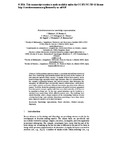Mostrar el registro sencillo del ítem
Paired structures in knowledge representation
| dc.creator | Montero, Javier | es_ES |
| dc.creator | Bustince Sola, Humberto | es_ES |
| dc.creator | Pagola Barrio, Miguel | es_ES |
| dc.creator | Fernández Fernández, Francisco Javier | es_ES |
| dc.creator | Barrenechea Tartas, Edurne | es_ES |
| dc.date.accessioned | 2020-09-22T07:53:16Z | |
| dc.date.available | 2020-09-22T07:53:16Z | |
| dc.date.issued | 2016 | |
| dc.identifier.issn | 0950-7051 | |
| dc.identifier.uri | https://hdl.handle.net/2454/38212 | |
| dc.description.abstract | In this position paper we propose a consistent and unifying view to all those basic knowledge representation models that are based on the existence of two somehow opposite fuzzy concepts. A number of these basic models can be found in fuzzy logic and multi-valued logic literature. Here it is claimed that it is the semantic relationship between two paired concepts what determines the emergence of different types of neutrality, namely indeterminacy, ambivalence and conflict, widely used under different frameworks (possibly under different names). It will be shown the potential relevance of paired structures, generated from two paired concepts together with their associated neutrality, all of them to be modeled as fuzzy sets. In this way, paired structures can be viewed as a standard basic model from which different models arise. This unifying view should therefore allow a deeper analysis of the relationships between several existing knowledge representation formalisms, providing a basis from which more expressive models can be later developed. | en |
| dc.description.sponsorship | This research has been partially supported by the Government of Spain (grants TIN2015-66471-P and TIN2013-40765-P), the Government of Madrid (grant S2013/ICCE-2845) and the UCM (Research Group 910149). | en |
| dc.format.extent | 21 p. | |
| dc.format.mimetype | application/pdf | en |
| dc.language.iso | eng | en |
| dc.publisher | Elsevier | en |
| dc.relation.ispartof | Knowledge-Based Systems, 2016, 100, 50-58 | en |
| dc.rights | © 2016 Elsevier Ltd. This manuscript version is made available under the CC-BY-NC-ND 4.0. | en |
| dc.rights.uri | http://creativecommons.org/licenses/by-nc-nd/4.0/ | |
| dc.subject | Knowledge representation | en |
| dc.subject | Paired structures | en |
| dc.subject | Neutral concepts | en |
| dc.subject | Bipolarity | en |
| dc.title | Paired structures in knowledge representation | en |
| dc.type | info:eu-repo/semantics/article | en |
| dc.type | Artículo / Artikulua | es |
| dc.contributor.department | Automática y Computación | es_ES |
| dc.contributor.department | Automatika eta Konputazioa | eu |
| dc.rights.accessRights | info:eu-repo/semantics/openAccess | en |
| dc.rights.accessRights | Acceso abierto / Sarbide irekia | es |
| dc.identifier.doi | 10.1016/j.knosys.2016.02.003 | |
| dc.relation.projectID | info:eu-repo/grantAgreement/MINECO//TIN2015-66471-P/ES/ | en |
| dc.relation.projectID | info:eu-repo/grantAgreement/MINECO//TIN2013-40765-P/ES/ | en |
| dc.relation.publisherversion | https://doi.org/10.1016/j.knosys.2016.02.003 | |
| dc.type.version | info:eu-repo/semantics/acceptedVersion | en |
| dc.type.version | Versión aceptada / Onetsi den bertsioa | es |



